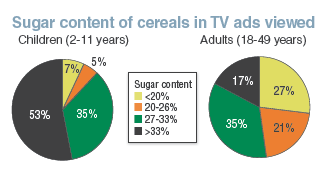Home »
Blog »
Cereal Facts released gives insight to the nutrition and marketing of cereal to kids
Cereal Facts released gives insight to the nutrition and marketing of cereal to kids
Posted on Jul 06, 2012 by Maggie LaBarbera
In 2009, Rudd Center reported the nutrition quality of cereals for children and how they were marketing to children. 
Today, 3 years later, a new report, Cereal f.a.c.t.s. 2012 has been released and here are the key findings:
What Has Improved for Kids:
Cereal companies improved the nutrition in the cereals that were marketed to kids.
-
Overall nutritional quality improved for 13 of 16 child-targeted brands by 10%
-
on average. Of the 22 different child-targeted cereals available in 2008 and 2011,
-
10 (45%) reduced the sodium,
-
7 (32%) reduced sugar,
-
5 (23%) increased fiber.
-
General Mills improved the nutritional quality of all of its child-targeted cereals.
-
Millsberry.com and Postopia.com—the two most popular children’s advergame sites—were discontinued, as were the Cap’n Crunch and Envirokidz child targeted websites. Due to the elimination of Millsberry.com, General Mills decreased banner advertising on children’s websites by 43%.
-
Preschoolers’ exposure to TV ads for all cereals declined by 6%, and their exposure to ads for child-targeted cereals decreased by 8%.
-
Among children ages 6-11, TV ad exposure declined for seven child-targeted cereals. Notably, ads for Kellogg’s Apple Jacks andCorn Pops went down by two-thirds, and ads for General Mills’ Cookie Crisp declined by 16%. Post stopped advertising Honeycomb on TV.

What Has Gotten Worse for Kids:
From 2008 to 2011, cereal
companies increased advertising to children for many of
their least nutritious products.
-
Total media spending to promote child-targeted cereals increased by 34%— from $197 million in 2008 to $264 million in 2011. General Mills, Kellogg, and Post ran campaigns to promote the nutritional quality of children’s cereals—their least nutritious products—to parents.
-
Children’s exposure to TV ads increased for seven child-targeted cereals— including Kellogg’s Froot Loops (+79%); General Mills’ Reese’s Puffs (+55%) and Trix (+29%); and Post’s Pebbles (+25%).
-
Post and General Mills launched new advergame websites—PebblesPlay.com, HoneyDefender.com (Honey Nut Cheerios), and CrazySquares.com (Cinnamon Toast Crunch).
-
In 2011, the number of child visitors increased for eight of 10 child-targeted websites that existed in 2008. On average in 2011, 162,000 children visited Kellogg’s FrootLoops.com and 116,000 children visited AppleJacks.com every month.
-
Kellogg nearly doubled banner advertising on children’s websites for its child targeted brands. General Mills increased banner advertising for four brands, including Honey Nut Cheerios (+185%), Lucky Charms (+58%), and Cinnamon Toast Crunch (which was not advertised in 2008-2009). Banner advertising for Post’s Pebbles doubled.
-
Kellogg introduced the first food company child-targeted advergame app for mobile phones and tablets: Apple Jacks “Race to the Bowl Rally.”
-
Despite an overall decline in TV ads for child-targeted cereals, black children's total exposure to TV ads for child-targeted brands increased by 7.5%—with the biggest increases for Kellogg’s Froot Loops (+88%) and General Mills’ Reese’s Puffs (+72%).
-
Cereal company spending on Spanish-language TV more than doubled— from $26 million to $65 million. Hispanic preschoolers, on average, saw 90 Spanish-language TV ads for cereals in 2011 (in addition to ads on English TV). Kellogg and General Mills launched new Spanish-language TV campaigns to promote Froot Loops and Cinnamon Toast Crunch.
-
Kellogg introduced Krave cereal in 2012. Although the CFBAI does not list Krave as a product that may be in child-directed advertising,3 children ages 6 to 11 have seen more TV ads for Krave than any other age group.
What does this all mean?
Bottom line is that cereal companies are still advertising their high sugary cereals to children. The healthy cereals are not marketed to kids, they are marketed to adults.
Sugary cereals are still the most ads that kids see on TV.
We can't rely on the cereal companies so parents, you need to stay strong and educate your children on how to choose healthy cereals that are lower in sugar and higher in fiber. You still are the biggest advertisement that your child sees and hears from every day!
More information on marketing to kids.
Learn more about Food Marketing
TV Ads And Kids
Types Of Foods Marketed
Fast Food Advertising




0 Comments